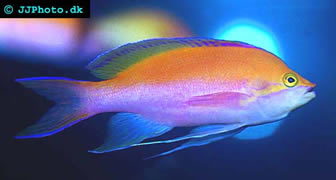Bicolor Anthias
Pseudanthias bicolor
Common name: Bicolor Anthias, Fancy bass anthias
Scientific name: Pseudanthias bicolor
Max size: 5 in / 13 cm
pH: 8.1-8.4
Salinity: 1.020-1.025
Temperature: 72-78ºF (22-26°C)
The bicolor anthias, or fancy bass anthias as it is also called, is one of the largest anthias species available in the trade. It is also one of the easiest anthias species to care for. It was described as a unique species in 1984.
It can, like all species of anthias, be hard to find unless you are patient as they are very popular but only occasionally collected. There are always anthias available on the market but which species varies depending on which species that have been collected at that time. Your local fish store can probably obtain it for you if you are willing to wait, or you can try to find bicolor anthias for sale online.
The name bicolor is both really suitable and simultaneously somewhat misguiding for this species as it in fact displays three colors. The upper half of the body is yellow or orange, the lower half can be anything from an almost white pinkish to pink or purple, and the edges of the fins are deep blue.
The Bicolor anthias is as earlier mentioned on one of the easiest anthias species to care for but it can still be quite sensitive and timid until it has properly acclimatized to your aquarium. When first introducing them to your aquarium you should allow them to acclimatize for 4 hours before releasing them. It is important that there are no aggressive fish to harass your bicolor anthias during the first weeks until they have made themselves at home in the tank, so it is a good idea to make this one of the first species you introduce to your aquarium. Once they feel at home they can be kept with more aggressive fish such as dwarf angels.
Bicolor anthias can be kept in groups with one male and several females or as a solitary fish. Never keep more than one male in the same aquarium.
The bicolor anthias is a superb reef fish that is 100% reef safe. They will not hurt ornamental shrimp or other invertebrates.
The bicolor anthias originates form the Indo-Pacific Ocean. They can be found from Mauritius to the Hawaiian and Line islands. They can be encountered as far north as the Japanese Ryukyu Islands and as far south as the Loyalty, Marshall and Caroline islands in Micronesia.
Bicolor Anthias care and aquarium setup
A single bicolor anthias can be kept in a 50 gallon / 200 L aquarium. They need large aquariums despite their petit size. If you want to keep a group of bicolor anthias you will need at least a 100 gallon / 400 L aquarium.
The aquarium should be decorated so that a lot of caves are created among live rock. It is also good if you create one or two large hangovers under which the fish can rest shaded from the light. It is important that the aquarium have plenty of open space for these fish to swim in. Bicolor anthias prefer rapidly moving water with a few calmer areas to rest in. Make sure that you keep your water quality high and stable as bicolor anthias are sensitive towards poor water quality. Bicolor anthias prefer a dimly lit aquarium. Keep the water well oxygenated.
Ideal conditions for the bicolor anthias is pH 8.1-8.4, salinity 1.020-1.025, and temperature 72-78ºF (22-26°C).
Feeding Bicolor Anthias
Bicolor anthias need to be fed often and given a good varied diet to thrive. They have small stomachs and only eat a little each time they eat. This means that they have to be fed often to get all the nutrients they need. Feed your bicolor anthias 4-5 times a day. Bicolor anthias feed on plankton in the wild. In the aquarium you have to provide them with a varied diet consisting of small food items such as finely chopped sea food, mysids shrimps, vitamin enriched brine shrimp, etc and if they accept it flake food.
Breeding Bicolor Anthias
Sexing bicolor anthias is not that hard as males are larger than females. They also have greatly elongated second and third dorsal spines with yellow cirrus on the ends. Only the third spine is elongated in females.
Bicolor anthias fish are hermaphrodites, protogynous hermaphrodites to be exact. Protogynous hermaphrodites are animals where all specimens are born females and then develop into males if the need arises. If the male for instance is eaten by a predator the dominant females will develop into a male. She can complete this transformation within a couple of weeks. Males can not revert back into females. No one has as far as we know successfully bred bicolor anthias in a home aquarium.
Anthias Articles
Threadfin Anthias – Care for this popular anthias, Nemanthias carberryi
Bartlett's Anthias – Information on how to keep Pseudanthias bartlettorum
Lyertail Anthias – How to keep and care for Pseudanthias squamipinnis

